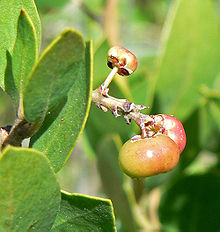- Arctostaphylos manzanita
-
Arctostaphylos manzanita 
Scientific classification Kingdom: Plantae (unranked): Angiosperms (unranked): Eudicots (unranked): Asterids Order: Ericales Family: Ericaceae Genus: Arctostaphylos Species: A. manzanita Binomial name Arctostaphylos manzanita
ParryOne of many species of manzanita, Arctostaphylos manzanita has the common names Common manzanita and Whiteleaf manzanita.
Arctostaphylos manzanita is endemic to California, where it can be found in the Coast Ranges and Sierra Nevada foothills. It is common on chaparral slopes and low-elevation coniferous forest ecosystems.
Contents
Description
The Arctostaphylos manzanita leaves are bright shiny green, wedge-shaped and pointed. The small white flowers, only a quarter inch long, are cup-shaped and hang upside down. The fruits are berries which are white when new and turn red-brown as the summer wears on. The bark on the long, crooked branches is reddish, making the shrub easily identifiable as a manzanita. It grows into a twisted tree about 15 feet tall.
Like other manzanitas, this species has a hard, attractive wood that has proved useful for making tools and as firewood. The fruit is edible and has a pleasant tartness, but it causes gastrointestinal upset if eaten in large quantities. It has historically been brewed into a cider.
Subspecies
There are several subspecies:
- A. m. elegans - Konocti manzanita
- A. m. glaucescens - Whiteleaf manzanita
- A. m. laevigata - Contra Costa manzanita
- A. m. manzanita - Whiteleaf manzanita
- A. m. roofii - Roof's manzanita
- A. m. wieslanderi - Wieslander's manzanita
See also
External links
References
- Casebeer, M. (2004). Discover California Shrubs. Sonora, California: Hooker Press. ISBN 0-9665463-1-8

This Ericaceae article is a stub. You can help Wikipedia by expanding it.
